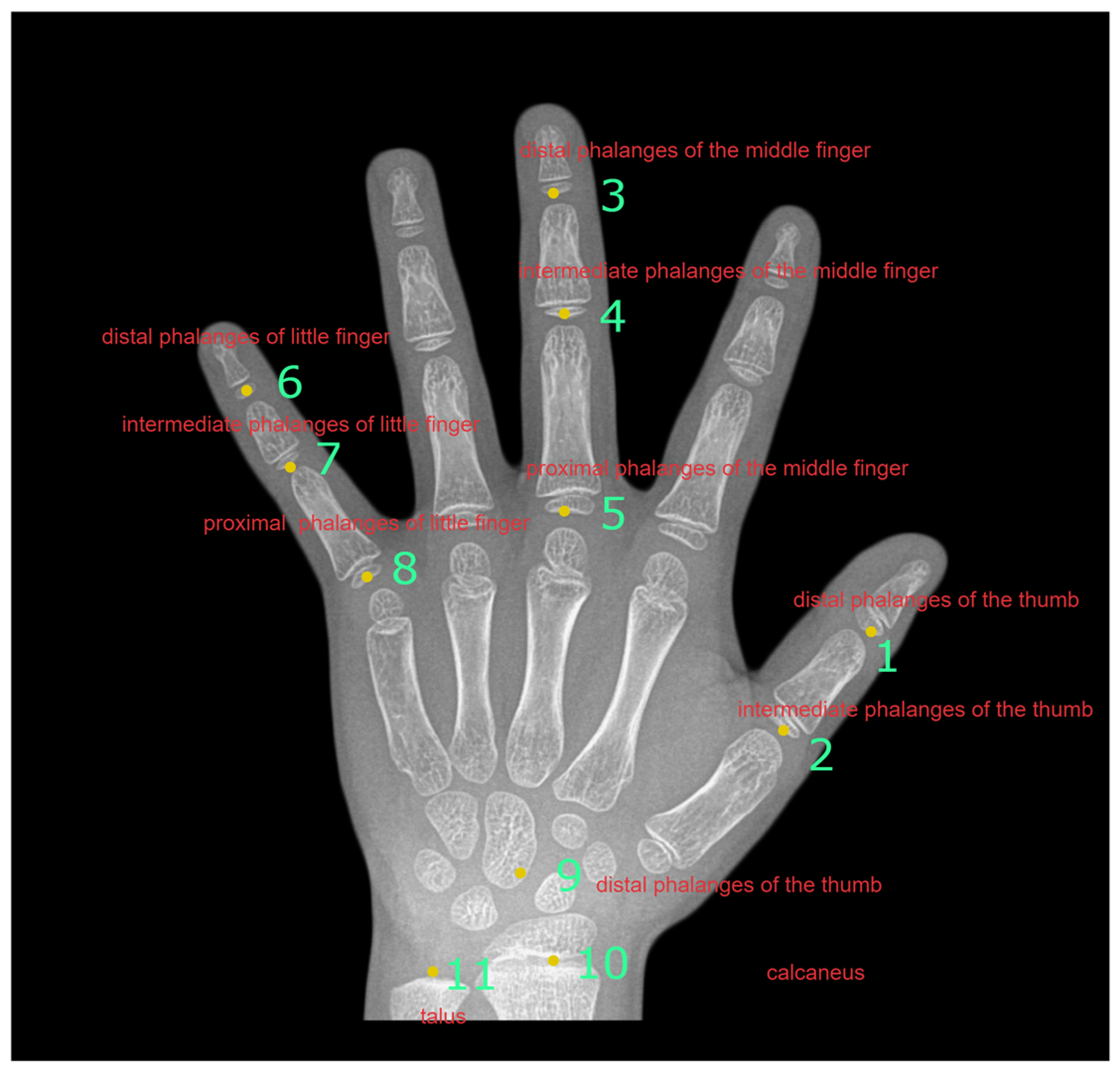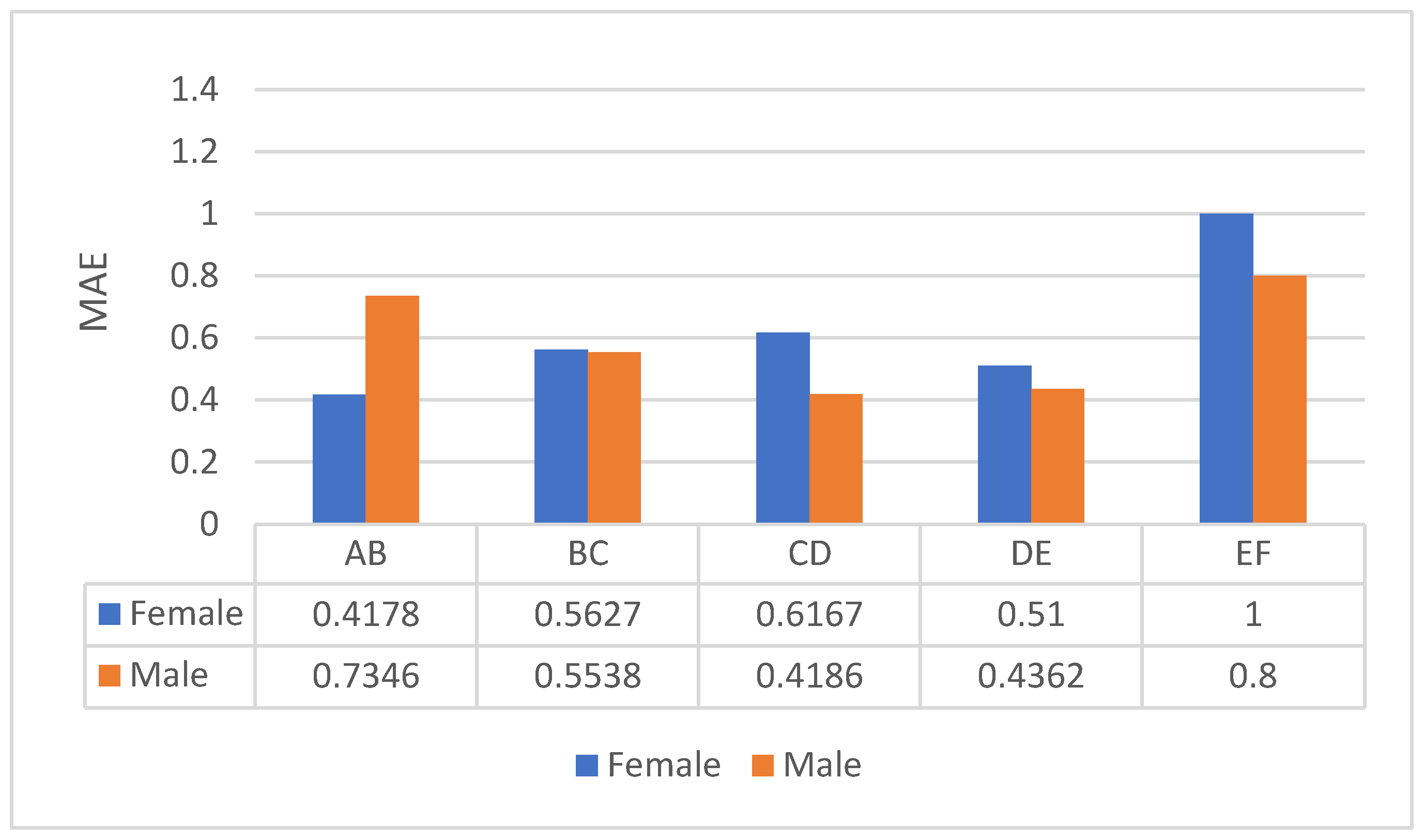Applying Convolutional Neural Network in Automatic Assessment of Bone Age Using Multi-Stage and Cross-Category Strategy
Abstract
1. Introduction
2. Convolutional Neural Network Framework
2.1. Convolutional Neural Network Framework
2.1.1. Convolutional Layer
2.1.2. Fully Connected Layer
3. Materials and Methods
3.1. Dataset
3.2. Framework of the MSCS-CNN
3.3. Step 1 of MSCS-CNN: Rough Maturity Stage Classification
3.4. Step 2 of MSCS-CNN: Fine Maturity Stage Classification
3.5. Step 3 of MSCS-CNN: REGRESSION MODEL
3.6. CNN-based Automatic Bone Age Assessment
3.7. Using the Cross-Stage Strategy to Avoid Over-Training
3.8. Evaluation Metrics
4. Experiments
4.1. One-Step Bone Age Regression
4.2. The Effect of Rough–Fine Classification
4.3. The Effect of Cross-Stage Classification
4.4. Maturity Stage Classification Configuration
4.5. Bone Age Assessment in Each Stagecs
4.6. Comparison with Other Bone Age Assessment Methods
5. Conclusions
Author Contributions
Funding
Institutional Review Board Statement
Informed Consent Statement
Data Availability Statement
Conflicts of Interest
References
- Garn, S.M. Radiographic atlas of skeletal development of the hand and wrist. Am. J. Hum. Genet. 1959, 11, 282. [Google Scholar]
- Tanner, J.M.; Healy, M.J.R.; Cameron, N.; Goldstein, H. Assessment of Skeletal Maturity and Prediction of Adult Height (tw3 Method); W.B. Saunders: Philadelphia, PA, USA, 2001. [Google Scholar]
- Tanzi, L.; Vezzetti, E.; Moreno, R.; Aprato, A.; Audisio, A.; Massè, A. Hierarchical fracture classification of proximal femur X-ray images using a multistage deep learning approach. Eur. J. Radiol. 2020, 133, 109373. [Google Scholar] [CrossRef] [PubMed]
- Guan, B.; Zhang, G.; Yao, J.; Wang, X.; Wang, M. Arm fracture detection in X-rays based on improved deep convolutional neural network. Comput. Electr. Eng. 2020, 81, 106530. [Google Scholar] [CrossRef]
- Urban, G.; Porhemmat, S.; Stark, M.; Feeley, B.; Okada, K.; Baldi, P. Classifying shoulder implants in X-ray images using deep learning. Comput. Struct. Biotechnol. J. 2020, 18, 967–972. [Google Scholar] [CrossRef]
- Rahman, T.; Chowdhury, M.E.; Khandakar, A.; Islam, K.R.; Islam, K.F.; Mahbub, Z.B.; Kadir, M.A.; Kashem, S. Transfer learning with deep convolutional neural network (CNN) for pneumonia detection using chest X-ray. Appl. Sci. 2020, 10, 3233. [Google Scholar] [CrossRef]
- Dang, J.; Li, H.; Niu, K.; Xu, Z.; Lin, J.; He, Z. Kashin-beck disease diagnosis based on deep learning from hand X-ray images. Comput. Methods Programs Biomed. 2021, 200, 105919. [Google Scholar] [CrossRef]
- Lee, H.; Tajmir, S.; Lee, J.; Zissen, M.; Yeshiwas, B.A.; Alkasab, T.K.; Choy, G.; Do, S. Fully automated deep learning system for bone age assessment. J. Digit. Imaging 2017, 30, 427–441. [Google Scholar] [CrossRef]
- Spampinato, C.; Palazzo, S.; Giordano, D.; Aldinucci, M.; Leonardi, R. Deep learning for automated skeletal bone age assessment in X-ray images. Med. Image Anal. 2017, 36, 41–51. [Google Scholar] [CrossRef]
- Zhao, C.; Han, J.; Jia, Y.; Fan, L.; Gou, F. Versatile framework for medical image processing and analysis with application to automatic bone age assessment. J. Electr. Comput. Eng. 2018, 2018, 2187247. [Google Scholar] [CrossRef]
- Liu, Y.; Zhang, C.; Cheng, J.; Chen, X.; Wang, Z.J. A multi-scale data fusion framework for bone age assessment with convolutional neural networks. Comput. Biol. Med. 2019, 108, 161–173. [Google Scholar] [CrossRef]
- Ren, X.; Li, T.; Yang, X.; Wang, S.; Ahmad, S.; Xiang, L.; Stone, S.R.; Li, L.; Zhan, Y.; Shen, D.; et al. Regression convolutional neural network for automated pediatric bone age assessment from hand radiograph. IEEE J. Biomed. Health Inform. 2018, 23, 2030–2038. [Google Scholar] [CrossRef] [PubMed]
- Larson, D.B.; Chen, M.C.; Lungren, M.P.; Halabi, S.S.; Stence, N.V.; Langlotz, C.P. Performance of a deep-learning neural network model in assessing skeletal maturity on pediatric hand radiographs. Radiology 2018, 287, 313–322. [Google Scholar] [CrossRef] [PubMed]
- Chen, X.; Li, J.; Zhang, Y.; Lu, Y.; Liu, S. Automatic feature extraction in X-ray image based on deep learning approach for determination of bone age. Future Gener. Comput. Syst. 2020, 110, 795–801. [Google Scholar] [CrossRef]
- Son, S.J.; Song, Y.; Kim, N.; Do, Y.; Kwak, N.; Lee, M.S.; Lee, B.-D. Tw3-based fully automated bone age assessment system using deep neural networks. IEEE Access 2019, 7, 33346–33358. [Google Scholar] [CrossRef]
- Liang, B.; Zhai, Y.; Tong, C.; Zhao, J.; Li, J.; He, X.; Ma, Q. A deep automated skeletal bone age assessment model via region-based convolutional neural network. Future Gener. Comput. Syst. 2019, 98, 54–59. [Google Scholar] [CrossRef]
- Bui, T.D.; Lee, J.-J.; Shin, J. Incorporated region detection and classification using deep convolutional networks for bone age assessment. Artif. Intell. Med. 2019, 97, 1–8. [Google Scholar] [CrossRef]
- Koitka, S.; Kim, M.S.; Qu, M.; Fischer, A.; Friedrich, C.M.; Nensa, F. Mimicking the radiologists’ workflow: Estimating pediatric hand bone age with stacked deep neural networks. Med. Image Anal. 2020, 64, 101743. [Google Scholar] [CrossRef]
- He, M.; Zhao, X.; Lu, Y.; Hu, Y. An improved alexnet model for automated skeletal maturity assessment using hand X-ray images. Future Gener. Comput. Syst. 2021, 121, 106–113. [Google Scholar] [CrossRef]
- Giordano, D.; Spampinato, C.; Scarciofalo, G.; Leonardi, R. An automatic system for skeletal bone age measurement by robust processing of carpal and epiphysial/metaphysial bones. IEEE Trans. Instrum. Meas. 2010, 59, 2539–2553. [Google Scholar] [CrossRef]
- Guo, L.; Wang, J.; Teng, J.; Chen, Y. Bone age assessment based on deep convolutional features and fast extreme learning machine algorithm. Front. Energy Res. 2022, 9, 888. [Google Scholar] [CrossRef]
- LeCun, Y.; Bottou, L.; Bengio, Y.; Haffner, P. Gradient-based learning applied to document recognition. Proc. IEEE 1998, 86, 2278–2324. [Google Scholar] [CrossRef]
- Krizhevsky, A.; Sutskever, I.; Hinton, G.E. Imagenet classification with deep convolutional neural networks. Adv. Neural Inf. Processing Syst. 2012, 25, 1097–1105. [Google Scholar] [CrossRef]
- He, K.; Zhang, X.; Ren, S.; Sun, J. Deep residual learning for image recognition. In Proceedings of the IEEE Conference on Computer Vision and Pattern Recognition, Las Vegas, NV, USA, 27–30 June 2016; pp. 770–778. [Google Scholar]
- Szegedy, C.; Ioffe, S.; Vanhoucke, V.; Alemi, A.A. Inception-v4, inception-resnet and the impact of residual connections on learning. In Proceedings of the Thirty-First AAAI Conference on Artificial Intelligence, San Francisco, CA, USA, 4–9 February 2017. [Google Scholar]
- Huang, G.; Liu, Z.; van der Maaten, L.; Weinberger, K.Q. Densely connected convolutional networks. In Proceedings of the IEEE Conference on Computer Vision and Pattern Recognition, Honolulu, HI, USA, 21–26 July 2017; pp. 4700–4708. [Google Scholar]
- Gilsanz, V.; Ratib, O. Hand Bone Age: A Digital Atlas of Skeletal Maturity; Springer Science & Business Media: Berlin/Heidelberg, Germany, 2005. [Google Scholar]
- Rosasco, L.; de Vito, E.; Caponnetto, A.; Piana, M.; Verri, A. Are loss functions all the same? Neural Comput. 2004, 16, 1063–1076. [Google Scholar] [CrossRef] [PubMed]
- Rajaraman, S.; Zamzmi, G.; Antani, S. Multi-loss ensemble deep learning for chest X-ray classification. arXiv 2021, arXiv:2109.14433. [Google Scholar]
- Díaz-Vico, D.; Fernández, A.; Dorronsoro, J.R. Companion losses for deep neural networks. In Proceedings of the International Conference on Hybrid Artificial Intelligence Systems, Bilbao, Spain, 22–24 September 2021; Springer: Berlin/Heidelberg, Germany, 2021; pp. 538–549. [Google Scholar]




| Maturity Stage | Number of Female X-ray Films | Number of Male X-ray Films |
|---|---|---|
| A | 3 | 4 |
| B | 63 | 59 |
| C | 463 | 4 |
| D | 677 | 441 |
| E | 59 | 93 |
| F | 20 | 40 |
| Total | 1285 | 1071 |
| Maturity Stage | of Female | of Female | of Male | of Male |
|---|---|---|---|---|
| AB | 2.5 | 0.5 | 2.7 | 1.0 |
| BC | 15.5 | 1.5 | 12.5 | 1.5 |
| CD | 15.5 | 5.0 | 16.0 | 4.4 |
| DE | 18.0 | 6.5 | 19.0 | 11.0 |
| EF | 18.0 | 12.0 | 19.0 | 13.5 |
| Input | Feature Extraction by Convolution | Output | ||||
|---|---|---|---|---|---|---|
| Block 1–8, 10–11 32 × 32 | Layer 1 | Layer 2 | Layer 3 | Step 1: 3 nodes (Softmax) Step 2: 2 nodes (Softmax) Step 3: 1 node (Sigmoid) | ||
| Residual block | Residual block | Residual block | ||||
| Conv 3 × 3128 | Conv 3 × 3256 | Conv 3 × 3256 | ||||
| Relu | Relu | Relu | ||||
| Conv 3 × 3128 | Conv 3 × 3256 | Conv 3 × 3256 | ||||
| Relu | Relu | Relu | ||||
| MaxPool (s = 2) | MaxPool (s = 2) | AveragePool | ||||
| Block 9 256 × 256 | Layer 1 | Layer 2 | Layer 3 | Layer 4 | Layer 5 | |
| Residual block | Residual block | Residual block | Residual block | Residual block | ||
| Conv 3 × 3128 | Conv 3 × 3256 | Conv 3 × 3256 | Conv 3 × 3512 | Conv 3 × 3512 | ||
| Relu | Relu | Relu | Relu | Relu | ||
| Conv 3 × 3128 | Conv 3 × 3256 | Conv 3 × 3256 | Conv 3 × 3512 | Conv 3 × 3512 | ||
| Relu | Relu | Relu | Relu | Relu | ||
| MaxPool (s = 2) | MaxPool (s = 2) | MaxPool (s = 2) | MaxPool (s = 2) | AveragePool | ||
| Method | MAE on Females | MAE on Males |
|---|---|---|
| Only step 3 | 1.225 | 1.421 |
| MSCS-CNN | 0.532 | 0.56 |
| Method | Females | Males |
|---|---|---|
| One-stage acc. | 0.87 | 0.83 |
| MSCS-CNN (two-stage) acc. | 1.0 | 0.96 |
| One-stage MAE | 1.745 | 1.49 |
| MSCS-CNN (two-stage) MAE | 0.532 | 0.56 |
| Method | Females | Males |
|---|---|---|
| 3-stage classification config. 1 | 1.0 | 0.96 |
| 3-stage classification config. 2 | 0.69 | 0.23 |
| Method | Females | Males |
|---|---|---|
| Config. 1 acc. | 0.76 | 0.79 |
| Config. 2 acc. | 0.42 | 0.41 |
| Config. 1 MAE | 1.299 | 1.412 |
| Config. 2 MAE | 1.436 | 1.478 |
| Method | MAE on Females | MAE on Males |
|---|---|---|
| Config. 1 | 0.497 | 0.51 |
| Config. 2 | 0.475 | 0.47 |
Publisher’s Note: MDPI stays neutral with regard to jurisdictional claims in published maps and institutional affiliations. |
© 2022 by the authors. Licensee MDPI, Basel, Switzerland. This article is an open access article distributed under the terms and conditions of the Creative Commons Attribution (CC BY) license (https://creativecommons.org/licenses/by/4.0/).
Share and Cite
Peng, C.-T.; Chan, Y.-K.; Yuh, Y.-S.; Yu, S.-S. Applying Convolutional Neural Network in Automatic Assessment of Bone Age Using Multi-Stage and Cross-Category Strategy. Appl. Sci. 2022, 12, 12798. https://doi.org/10.3390/app122412798
Peng C-T, Chan Y-K, Yuh Y-S, Yu S-S. Applying Convolutional Neural Network in Automatic Assessment of Bone Age Using Multi-Stage and Cross-Category Strategy. Applied Sciences. 2022; 12(24):12798. https://doi.org/10.3390/app122412798
Chicago/Turabian StylePeng, Ching-Tung, Yung-Kuan Chan, Yeong-Seng Yuh, and Shyr-Shen Yu. 2022. "Applying Convolutional Neural Network in Automatic Assessment of Bone Age Using Multi-Stage and Cross-Category Strategy" Applied Sciences 12, no. 24: 12798. https://doi.org/10.3390/app122412798
APA StylePeng, C.-T., Chan, Y.-K., Yuh, Y.-S., & Yu, S.-S. (2022). Applying Convolutional Neural Network in Automatic Assessment of Bone Age Using Multi-Stage and Cross-Category Strategy. Applied Sciences, 12(24), 12798. https://doi.org/10.3390/app122412798







